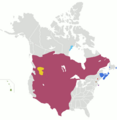Lingua franca facts for kids
A lingua franca (originally Italian for "Frankish language" - see etymology below) is a language that is used between persons who do not have the same mother tongue.
The terms working language, bridge language and vehicular language are used in the same sense.
Etymology
Around the Renaissance era a mixed language of Italian (80%) and many words from Turkish, French, Spanish, Greek and Arabic was used in the eastern region around the Mediterranean Sea It was in use as the language of commerce and diplomacy and was called lingua franca. At that time, in the port cities of the Ottoman empire there lived very many Italian speakers. Franca was the Italian word for Frankish. Its usage in the term lingua franca came from its meaning in Arabic. That word came into use before the Crusades, when Europeans used to be called "Franks" or Faranji in Arabic. The term lingua franca is first recorded in English in 1678.
Examples
There are many languages in all continents that are used as lingua franca.
In Africa: Afrikaans, Berber, Fanagalo, Fula, Hausa, Krio, Manding, Sango, Swahili, Wolof
In Asia: Akkadian, Arabic, Aramaic, Azeri, Bengali, Chinese, Hebrew, Hindi-Urdu, Malay-Indonesian, Nepali, Persian, Sanskrit
In Europe: English, French, German, Greek, Italian, Latin, Polish, Portuguese, Russian, Serbo-Croatian, Spanish, Yiddish
In Pre-Columbian America: Chinook Jargon, Nahuatl, Quechua, Tupi
Pidgins and creoles: Guinea-Bissau Creole, Tok Pisin
All continents : Esperanto as an auxiliary lingua franca
For some of them some explanations may be given.
English
English is the current lingua franca of international business, science, technology and aviation. It has replaced French as the lingua franca of diplomacy since World War II. The rise of English in diplomacy began in 1919, after World War I, when the Treaty of Versailles was written in English as well as in French. The use of English profited from the important international role of English-speaking nations (the United States and the Commonwealth of Nations) after World War II, particularly in the establishment and organization of the United Nations. English is one of the six official languages of the United Nations (the other five are French, Arabic, Chinese, Russian and Spanish).
When the United Kingdom became a colonial power, English was the lingua franca of the colonies of the British Empire. In the post-colonial period, some of the newly created nations which had many indigenous languages decided to continue using English as the lingua franca to avoid the political difficulties that had developed if one had decided to use only one of the indigenous languages.
French
French was the language of diplomacy in Europe from the 13th century, and as a result is still a working language of international institutions and is seen on documents ranging from passports to airmail letters. For many years, until the United Kingdom, Ireland, and Denmark joined in 1973, French and German were the only official working languages of the European Economic Community. French was also the lingua franca of European literature in the 18th century.
German
German was a lingua franca in large portions of Europe for centuries, mainly the Holy Roman Empire.
As it was one of the official languages of the Austro-Hungarian Empire, German remained an important second language in much of Central and Eastern Europe long after World War I. Today, it is still the most common second language in some of the countries in the region (e.g. in Slovenia (45% of the pop.), Croatia (34%), the Czech Republic (31%) and Slovakia (28%)). In others, it is also known by significant numbers of the population (in Poland by 18%, in Hungary by 16%).
Greek and Latin
During the time of the Roman Empire, the lingua francas were Greek and Latin. During the Middle Ages, the lingua franca was Greek in the parts of Europe, Middle East and Northern Africa where the Byzantine Empire had much influence, and Latin was used in the rest of Europe. Latin was used as the common language of the Roman Catholic Church. During the Second Vatican Council, Catholic liturgy changed to local languages, although Latin remains the official language of the Vatican. Latin was used as the language of scholars in Europe until the early 19th century in most subjects.
- Heine, Bernd (1970). Status and Use of African Lingua Francas. ISBN: 3-8039-0033-6
- Kahane, Henry Romanos (1958). The Lingua Franca in the Levant.
- R. A. Hall, Jr. (1966). Pidgin and Creole Languages, Cornell University Press. ISBN: 0-8014-0173-9.
- MELATTI, Julio Cezar (1983). Índios do Brasil. São Paulo:Hucitec Press, 48th edition
Images for kids
See also
 In Spanish: Lengua franca para niños
In Spanish: Lengua franca para niños





